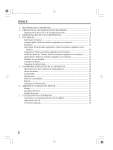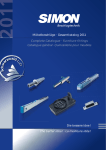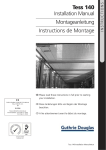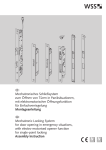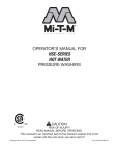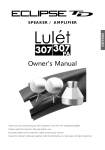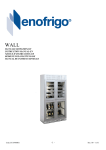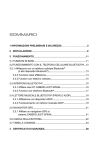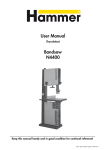Download THESIS 2.0
Transcript
THESIS 2.0 MANUALE ISTRUZIONI Gentile Cliente, grazie per aver scelto di accordarci la sua fiducia utilizzando i nostri prodotti. La ricerca e l’esperienza che FIAM ha acquisito hanno portato alla realizzazione di un prodotto che al momento offre il massimo risultato in termini di affidabilità e prestazioni. Thesis 2.0 è disponibile nelle versioni NC e NA (normalmente chiusa e normalmente aperta in caso di assenza di alimentazione). Può essere montata sia verticalmente che orizzontalmente ed è disponibile con tre differenti software, per il funzionamento in modalità “stand alone”, “interblocco manuale” oppure “interblocco automatico”. Consulti il nostro catalogo prodotti o ci contatti per chiarire qualsiasi dubbio tecnico o commerciale possa avere: saremo ben lieti di fornirle tutte le informazioni necessarie. Per conoscere al meglio il prodotto e sfruttare tutte le sue prestazioni, legga e conservi questo manuale: le tornerà utile per una nuova eventuale gestione, nonché per la sua ordinaria manutenzione. INDICE IT 1. CARATTERISTICHE TECNICHE................................................................................................................................................. 1-5 1.1 Dimensioni e installazione serratura..................................................................................................................................... 1-6 1.2 Installazione serratura e cilindro............................................................................................................................................ 1-7 1.3 Dimensioni e installazione contropiastra.............................................................................................................................. 1-8 1.4 Regolazione contropiastra...................................................................................................................................................... 1-9 esempio di applicazione (varco singolo)................................................................................................................................ 1-10 esempio di interblocco manuale o automatico..................................................................................................................... 1-11 2. COLLEGAMENTI ELETTRICI..................................................................................................................................................... 1-12 2.1 Fissaggio dei cavi e del connettore........................................................................................................................................ 1-13 3. MODALITÀ DI FUNZIONAMENTO............................................................................................................................................. 1-14 3.1 Funzionamento TOTAL............................................................................................................................................................. 1-14 3.2 Funzionamento FREE.............................................................................................................................................................. 1-14 4. CONFIGURAZIONE DEL RELÈ.................................................................................................................................................. 1-15 4.1 Configurazione e accesso al relè di programmazione.......................................................................................................... 1-16 5. REGOLAZIONE DEI TEMPI DI “CORTESIA” E DI “RITARDO CHIUSURA”............................................................................. 1-17 5.1 Regolazione del “tempo di cortesia” (T1).............................................................................................................................. 1-17 5.2 Regolazione del “ritardo di chiusura” all’accostamento dell’anta (T2)............................................................................... 1-17 6. COLLEGAMENTI IN INTERBLOCCO MANUALE O AUTOMATICO........................................................................................... 1-18 7. CONFIGURAZIONE DI THESIS 2.0 CON LA GAMMA STYLOS............................................................................................... 1-19 7.1 Configurazione e accesso ai jumpers di indirizzo bus........................................................................................................... 1-19 7.2. Accesso ai pulsanti di programmazione................................................................................................................................ 1-20 1-3 AVVERTENZE • La non osservanza di quanto descritto in questo manuale pregiudica il corretto funzionamento della serratura, con la conseguente perdita della garanzia del prodotto. • Il prodotto può essere destinato solo all’uso per il quale è stato espressamente concepito. Ogni altro uso è da considerarsi improprio e pericoloso. • È opportuno prevedere a monte dell’alimentatore, un appropriato interruttore di sezionamento e protezione. • Non usare la serratura come dima di foratura. • Non verniciare o lubrificare la serratura • Verificare che il pistone sia sempre libero da attriti e pulito. Nel caso si intenda pulire il pistone, non utilizzare materiali che possano filtrare all’interno della serratura. • Si consiglia di dotare l’anta di una molla chiudiporta con regolazione del tratto finale, onde evitare le azioni di rimbalzo della porta. 1-4 • In caso di assenza di alimentazione, l’elettropistone versione NC può essere aperto solo meccanicamente tramite il cilindro o la maniglia (ove prevista). Viceversa, l’elettropistone versione NA senza alimentazione non può essere chiuso meccanicamente. • FIAM srl non è tenuta al rispetto delle condizioni di garanzia qualora il prodotto risulti essere stato oggetto di modifiche, riparazioni o alterazioni da personale non autorizzato. • Al fine di migliorare la qualità o per esigenze produttive e commerciali, Fiam srl si riserva il diritto di apportare tutte le modifiche che riterrà opportune al prodotto e al manuale di istruzioni senza preavviso, al fine di migliorarne la qualità o per esigenze produttive e commerciali. 1. CARATTERISTICHE TECNICHE IT • Entrata: 25/30/35 mm. • Disponibile nelle versioni NC (normalmente chiusa) e NA (normalmente aperta) in assenza di alimentazione. • Disponibile con software di funzionamento per varco singolo, per interblocco manuale bidirezionale e per interblocco automatico bidirezionale (la comunicazione tra le serrature in interblocco è cifrata) • Tensione di alimentazione in corrente continua: 8÷30 Vdc • Corrente massima assorbita durante il funzionamento: 1A • Caratteristiche minime dell’alimentatore in corrente continua: 8÷30 Vdc 15 W • Canale di comunicazione: interfaccia seriale multipunto “LOCKBUS” (3 fili: alimentazione/dati) • Comando apertura: ingresso optoisolato 8÷24Vdc/12Vac • Relè di segnalazione: tensioni e correnti massime applicabili 24 Vdc 1A/120 Vac 0.5 A • • Tempo di cortesia: programmabile da 1÷180 sec. (15 sec. default) • Tempo di richiusura all’accostamento dell’anta: programmabile da 1÷60 sec. (1 sec. default) • Temperatura minima e massima di funzionamento -20°C +60°C (-4°F 140°F) • Temperatura di stoccaggio -25°C + 70° C (-13°F 158°F) • Sistema protettivo (grado IP) IP44 • Normativa di riferimento: EN 14846:2008 • Classificazione: 3 C 1 0 0 D 3 1 1 • Dimensioni della confezione: larghezza 38,5 cm/profondità 10 cm/altezza 4 cm • Peso della confezione: 1,4 kg. • Contenuto della confezione: serratura, contropiastra, libretto istruzioni multilingue (IT/GB/FR/DE/ES), viti di fissaggio, connettore con relativa protezione in gomma, quadro maniglia 8 mm (se previsto). 1-5 1.1 DIMENSIONI E INSTALLAZIONE SERRATURA 38 / 43 / 48 15 25 /32 61,5 85 22/27 ø14 1-6 15 45 25 / 30 / 35 85 295 341 22 33 20 23 371 3 296 ATTENZIONE Prestare attenzione a non danneggiare il cavo durante l’installazione. (vedi nota a pag. 12/13) 1.2 INSTALLAZIONE SERRATURA E CILINDRO ATTENZIONE Utilizzare solo cilindri a profilo europeo, camma DIN. Se si utilizzano cilindri dotati di camma antistrappo posizionata a 30° o 45°, orientare la camma come indicato in figura. IT La posizione raffigurata si deve ottenere con la chiave disinserita. La non osservanza di quanto sopra pregiudica il corretto funzionamento della serratura. ø18 34 Dopo aver fissato il cilindro nella relativa sede, bloccarlo con la vite in dotazione. 11 1-7 7,5 330 24 3 315 20 1-8 40,5 7,5 33 94 ø23 23 Il mancato utilizzo della sfera di allineamento anta (in dotazione) pregiudica il corretto funzionamento. ø19 NOTA Fissare correttamente la contropiastra affinchè, a installazione ultimata con porta chiusa, il pistone risulti libero da attriti con la contropiastra stessa. 31,5 1.3 DIMENSIONI E INSTALLAZIONE CONTROPIASTRA 1.4 REGOLAZIONE CONTROPIASTRA Regolare il sensore di “riscontro anta” (1) a una distanza massima dal frontale della serratura di 5 mm. Distanze superiori a quanto indicato pregiudicano il corretto funzionamento della serratura in fase di richiusura automatica del pistone. Regolare la sporgenza della sfera di allineamento anta (2), agendo con un cacciavite in senso orario o antiorario. 2 1 3 2/3 IT Regolare la forza di spinta della sfera (3). Per questa operazione inserire un piccolo cacciavite nel foro della sfera fino a raggiungere la vite posta sul tappo in ottone. Ruotare in senso antiorario per aumentare la forza di spinta, orario per diminuirla. NOTA Prestare attenzione a non eccedere nel ruotare in senso orario il cacciavite, (3) in quanto si rischia di svitare il tappo posteriore che tiene la molla inserita nel gruppo. 1-9 Esempio di applicazione (varco singolo) 1. Serratura Thesis 2.0 2. Contropiastra serratura 3. Cilindro 4. Tastiera serie Stylos 5. Passacavo 6. Pulsante apertura 7. Chiuporta 8. Alimentatore 7 4 6 1 2 3 5 L’immagine a lato ha l’unico scopo di fornire un esempio di applicazione del prodotto. Consulti il catalogo per verificare tutti gli accessori disponibili per la serie Thesis 2.0 o ci contatti per chiarire qualsiasi dubbio tecnico o commerciale. 1-10 8 Esterno Interno Esempio di interblocco manuale o automatico 1. Serratura Thesis 2.0 2. Contropiastra serratura 3. Cilindro 4. Semaforo con pulsante 5. Passacavo 6. Chiudiporta 7. Alimentatore 6 4.1 4.2 1 2 3 5 7 Esterno IT varco interbloccato Interno ATTENZIONE Nel caso di installazione in interblocco automatico i semafori interni ai varchi (4.2) non sono dotati del pulsante apertura. NOTA Il canale di comunicazione garantisce una comunicazione criptata tra le serrature Thesis 2.0. 1-11 2.COLLEGAMENTI ELETTRICI Canale di comunicazione (BUS) Positivo alimentazione 8÷30 VDC 1A (+) ALIMENTAZIONE Negativo alimentazione GND (-) Contatto comune relè di segnalazione (COM) Contatto normalmente chiuso relè di segnalazione (NC) Contatto normalmente aperto relè di segnalazione (NO) 8÷24 VDC/12 VAC Comando APERTURA ingresso optoisolato T1 pulsante apertura (non in dotazione) ATTENZIONE Sezione minima dei fili di alimentazione in funzione della lunghezza dell’impianto: fino a 10 m sezione. 0.5 mm 10÷40 m sezione. 0.75 mm 40÷50 m sezione. 1 mm 50÷75 m sezione. 1.5 mm 75÷100 m sezione. 2.5 mm Prestare attenzione a non danneggiare i cavi installando la serratura nell’infisso. 1-12 2.1 FISSAGGIO DEI CAVI E DEL CONNETTORE ATTENZIONE Per proteggere il circuito elettronico da agenti esterni, utilizzare il tappo nero in gomma tra i cavi ed il connettore verde (tappo nero in gomma e connettore estraibile entrambi in dotazione). IT Dopo aver fissato i cavi nel connettore verde estraibile (1), inserire il connettore stesso nel connettore fisso presente nella parte superiore della serratura (2). Coprire i connettori con il tappo nero in gomma, fissandolo alla serratura con la vite in dotazione. 1-13 3. MODALITÀ DI FUNZIONAMENTO 3.1 Funzionamento TOTAL 3.2 Funzionamento FREE Se il comando di apertura è inferiore ad 1 sec. la serratura si apre e si mantiene in apertura a porta accostata per il tempo di cortesia impostato. Se la porta viene aperta prima dello scadere del tempo di cortesia, al successivo accostamento dell’anta la serratura rilascia il pistone in chiusura mettendo in sicurezza il varco. Se il comando di apertura viene mantenuto attivo (stato) la serratura ignora il tempo di cortesia impostato e tiene arretrato il pistone in apertura fino a quando non viene disattivato il comando di apertura. In questa modalità l’accesso al varco è sempre garantito: dopo ogni accostamento la serratura non richiude (modalità di “fermo a giorno”). 1-14 4. CONFIGURAZIONE DEL RELÈ Se la serratura viene utilizzata in ambito locale (varco singolo) è possibile configurarne il relè tramite i jumpers in dotazione per ottenere una delle seguenti segnalazioni: IT “STATO PORTA IN SICUREZZA” (pistone estratto e anta accostata). Nota: questa condizione è già impostata in fabbrica in tutte le serrature che utilizzano un software di funzionamento “standard”. “COMANDO PER APRIPORTA MOTORIZZATO” (a pistone arretrato, impulso di 1 sec.). Togliere l’alimentazione, inserire il jumper JP1 come raffigurato a lato e ridare alimentazione. 1-15 4. CONFIGURAZIONE DEL RELÈ 4.1 Configurazione e accesso al relè di programmazione. Rimuovere l’etichetta (figura a lato) per accedere ai ponticelli di configurazione (JP1/2/3/4). A operazione conclusa riposizionare l’etichetta. NOTA Se il jumper JP1 è disinserito, il relè viene configurato direttamente dalle impostazioni del software della serratura. 1-16 JP4 JP3 JP2 JP1 5. REGOLAZIONE DEI TEMPI DI “CORTESIA” E DI “RITARDO CHIUSURA” 5.1 Regolazione del “tempo di cortesia” (T1) IT Per modificare il tempo di cortesia della serratura, impostato in fabbrica a 15 sec. agire come segue: predisporre la serratura alimentata in condizioni di pistone arretrato e anta non accostata (pistone e porta aperti); premere il pulsante P1 per il tempo desiderato, da 1 a 180 sec. (durante la fase di programmazione il LED L1 lampeggia una volta ogni secondo). 5.2 Regolazione del “ritardo chiusura” all’accostamento dell’anta Per modificare il tempo di “ritardo chiusura” all’accostamento dell’anta della serratura, impostato in fabbrica a 1 sec., agire come segue: predisporre la serratura alimentata in condizioni di pistone arretrato e anta non accostata (pistone e porta aperti); premere il pulsante P2 per il tempo desiderato, da 1 a 60 sec. (durante la fase di programmazione il LED L1 lampeggia una volta ogni secondo). Accesso ai pulsanti di programmazione P1 e P2. ATTENZIONE In caso di utilizzo della serratura in interblocco con altri dispositivi tramite il canale di comunicazione LOCKBUS, per un corretto funzionamento del sistema non impostare il tempo T2 ad un valore inferiore a 1 sec. 1-17 6. COLLEGAMENTI IN INTERBLOCCO MANUALE O AUTOMATICO Per ottenere un interblocco manuale o automatico tra due elettropistoni Thesis 2.0 dotati di software apposito e connessi tra loro tramite il canale di comunicazione criptato, procedere come segue: 1. Collegare tra loro i PIN 1 di entrambe le serrature (canale di comunicazione) e i rispettivi PIN 2 e PIN 3 con la stessa fonte di alimentazione ma NON dare alimentazione: si consiglia di non inserire i connettori già cablati in ciascuna serratura (vedi figura a lato). 2. Inserire il ponticello JP4 in una delle sue serrature e tenendo premuto a scelta uno dei due pulsanti della stessa, dare alimentazione solo a questa serratura (inserire il connettore cablato). Attendere almeno 2 sec. prima di rilasciare il pulsante. 1-18 3. Mantenendo accesa la serratura precedentemente configurata (punto 2) individuare la serratura senza ponticello JP4; tenendo premuto a scelta uno dei due pulsanti, dare alimentazione anche a questa serratura (inserire il connettore cablato). Attendere almeno 2 sec. prima di rilasciare il pulsante premuto. Dopo alcuni secondi verrà attivata la comunicazione tra le serrature, che funzioneranno nella modalità interblocco prevista dal software (manuale o automatico). NOTA Le procedure sopra descritte vanno eseguite con le porte aperte. Esempio di collegamento tra due serrature interbloccate 12345678 NOTA 12345678 Se previsto dalle specifiche dell’impianto, collegare i semafori di segnalazione al relè di stato porta in sicurezza di ciascuna serratura (PIN 4/5/6), e il pulsante apertura corrispondente (PIN 7/8 ingresso optoisolato). Prevedere l’utilizzo di un alimentatore adeguato (la singola serratura consuma 15 W). 7. CONFIGURAZIONE DI THESIS 2.0 CON LA GAMMA STYLOS 7.1 Configurazione e accesso ai jumpers di indirizzo bus. IT Rimuovere l’etichetta (figura a lato) per accedere ai ponticelli di configurazione (JP1/2/3/4). A operazione conclusa riposizionare l’etichetta. JUMPERS INDIRIZZO BUS INDIRIZZO 1 JP4 JP3 JP2 JP1 INDIRIZZO 3 INDIRIZZO 5 INDIRIZZO 7 1-19 7. CONFIGURAZIONE DI THESIS 2.0 CON LA GAMMA STYLOS 7.2 Accesso ai pulsanti di programmazione. ATTENZIONE Predisporre la serratura in condizioni di pistone arretrato e anta non accostata. I collegamenti elettrici sono descritti a pagina 12. LEGENDA: P1/PP2 = Pulsanti di programmazione L1 = LED LOCKBUS tipo I/II Accesso ai pulsanti di profgrammazione P1 e P2 1-20 Iseo Serrature s.p.a. Via San Girolamo 13 25055 Pisogne (BS) ITALY Tel +39 0364 8821 [email protected] Thesis 2.0 - Manuale d’installazione www.iseo.com Fiam s.r.l. Via Don Fasola 4 22069 Rovellasca (CO) ITALY Tel +39 02 96740420 [email protected] IT ELECTRONIC SUPPORT SERVICE [email protected] MONDAY - FRIDAY 8am - 12am / 1pm - 5pm 1-21 Dear Customer, We appreciate your trust in using our products. The research and the experience acquired by FIAM have led to the creation of a product that currently offers the best results in terms of reliability and performance. Thesis 2.0 is available in versions NC and NO (normally closed and normally open, should a power supply not be available). It may be set up vertically or horizontally, and is available with three different softwares, to function in “stand alone,” “manual interlocking,” or “automatic interlocking” modes. Please feel free to consult our product manual or contact us for any technical or commercial questions you may have: we would be happy to provide you with all the information you need. To get to know our product better and take advantage of all of its functions, please read and save this manual: it will be useful for any likely future operations as well as routine maintenance. INDEX 1. TECHNICAL CHARACTERISTICS.............................................................................................................................................. 1-5 1.1 Lock dimensions and installation........................................................................................................................................... 1-6 1.2 Lock and cylinder installation................................................................................................................................................. 1-7 1.3 Dimensions and installation of the striking plate................................................................................................................. 1-8 1.4 Striking plate adjustments...................................................................................................................................................... 1-9 application example (single door).......................................................................................................................................... 1-10 manual or automatic interlocking examples......................................................................................................................... 1-11 GB 2. ELECTRICAL CONNECTIONS.................................................................................................................................................... 1-12 2.1 Fastening the cables and the connector............................................................................................................................... 1-13 3. FUNCTION MODES.................................................................................................................................................................... 1-14 3.1 TOTAL setting............................................................................................................................................................................ 1-14 3.2 FREE setting............................................................................................................................................................................. 1-14 4. RELAY CONFIGURATIONS........................................................................................................................................................ 1-15 4.1 Configuration and access to the programming relay............................................................................................................ 1-16 5. SETTING THE “COURTESY” AND “DELAYED CLOSURE” TIMINGS....................................................................................... 1-17 5.1 Setting the “courtesy time” (T1)............................................................................................................................................. 1-17 5.2 Setting the “delayed closure” on the closing of the door (T2)............................................................................................. 1-17 6. CONNECTIONS FOR MANUAL OR AUTOMATIC INTERLOCKING.......................................................................................... 1-18 7. CONFIGURATION OF THESIS 2.0 WITH STYLOS LINE........................................................................................................... 1-19 7.1 Configuration and access to address bus jumper................................................................................................................. 1-19 7.2. Access to the programming buttons...................................................................................................................................... 1-20 1-3 WARNINGS • Failure to comply with the instructions laid out in this manual will affect the proper functioning of the lock, with consequent loss of warranty. • This product can only be used for what it was specifically designed to do. Any other use is considered irregular and dangerous. • Provisions should be made to ensure that a suitable isolation and protection switch be placed upstream of the power supply. • Do not use the lock as a drilling template. • Do not paint or lubricate the lock. • Always ensure the bolt is clean and free of friction. In case the valve needs to be cleaned, do not use products that can leak into the lock. • We recommend you equip the door with a door closer to prevent rebound when closing the door. 1-4 • If there is no power supply, the NC version of the solenoid lock can only be opened mechanically through the cylinder or the handle (where applicable). On the other hand, the NA version of the solenoid lock cannot be mechanically closed if there is no power supply. • FIAM srl. is not required to comply with warranty conditions if the product has been subjected to changes, repairs or alterations by unauthorized personnel. • For manufacturing and commercial reasons, or to improve the quality of its product, FIAM srl reserves the right to make any changes it deems appropriate to the product and its instruction manual without prior notice. 1. TECHNICAL CHARACTERISTICS • Entry: 25/30/35 mm. • Available in version NC (normally closed) and NO (normally open) in the absence of a power supply. • Available with activation software for single door, for bidirectional manual interlocking, and for bidirectional automatic interlocking (the communication between the interlocking locks is encrypted). • DC Voltage power supply: 8 to 30VDC • Maximum supply current during operation: 1A • Minimum supply current: 8 to 30VDC, 15W • “LOCKBUS” communication channel: multi-point serial interface (3 wires: power/data) • Opening control: optically isolated input 8 to 24Vdc/12Vac • Signal relays: voltage and maximum applicable current 24Vdc 1A/120Vac 0.5A • Courtesy time: programmable from 1 to 180 seconds (default: 15 seconds) • Locking time at closing of the door: programmable from 1 to 60 seconds (default: 1 second) • Temperature range of operation: -20°C to +60°C (-4°F to 140°F) • Storage temperature: -25°C to +70°C (-13°F to 158°F) • Protection system (IP grade) IP44 • Reference standards: EN 14846:2008 • Classification: 3 C 8 0 0 G 3 0 1 • Packaging dimensions: width 38.5 cm - depth 10 cm height 4 cm • Package weight: 1.4 kg • Package contents: lock, striking plate, multilingual instruction booklet (IT/GB/FR/DE/ES), screws, connector with rubber protection, 8mm handle bracket (if envisioned). 1-5 GB 1.1 DIMENSIONS AND LOCK INSTALLATION 38 / 43 / 48 15 25 /32 61,5 85 22/27 ø14 1-6 15 45 25 / 30 / 35 85 295 341 22 33 20 23 371 3 296 CAUTION Take care to avoid damaging the cable during installation (see notes on pages 12 and 13) 1.2 LOCK AND CYLINDER INSTALLATION CAUTION Use only European profile cylinders, cam DIN. If you use cylinders provided with positive fit cam positioned at 30° or 45°, then the cam should be oriented as illustrated. The position shown should be achieved with the key d sconnected. Noncompliance with what is indicated above will compromise the correct functioning of the lock. GB ø18 34 After positioning the cylinder in its place, secure with the screw provided. 11 1-7 7,5 330 24 3 315 20 1-8 40,5 7,5 33 94 ø23 23 Failure to use the door’s alignment sphere (supplied) will compromise the correct functioning of the lock. ø19 NOTE Correctly secure the striking plate so that once the installation is complete and the door is closed, the bolt does not scrape against the striking plate itself. 31,5 1.3 DIMENSIONS AND INSTALLATION OF THE STRIKING PLATE 1.4 STRIKING PLATE ADJUSTMENTS Adjust the “door positioning” sensor (1) to a maximum distance of 5 mm from the front of the lock. Distances greater than this will compromise the correct functioning of the lock in the automatic closing phase of the bolt. GB Adjust the protrusion of the door (2) alignment sphere working a screwdriver in a clockwise or counter-clockwise direction. 2 1 3 2/3 Adjust the thrust force of the sphere (3). To this end, insert a small screwdriver into the sphere’s opening until you reach the screw placed on the brass cap. Turn counter-clockwise to increase the pressure of the thrust, or in a clockwise direction to diminish it. NOTE Be careful not to excessively turn the screwdriver clockwise (3), as you may run the risk of unscrewing the rear cap, which holds the spring in place, inserted in the group. 1-9 Application example (single door) 1. Thesis 2.0 lock 2. Lock striking plate 3. Cylinder 4. Stylos series keyboard 5. Conduit 6. Opening button 7. Spring-loaded damper 8. Power supply 7 4 6 1 2 3 5 The image on the left serves only as an example of this product in use. Please consult the catalogue to see all available accessories for the series Thesis 2.o, or contact us for any technical or sales questions. 1-10 8 Exterior Interior Manuel or automatic interlocking example 1. Thesis 2.0 lock 2. Lock striking plate 3. Cylinder 4. Indicator light with push button 5. Conduit 6. Door-closer 7. Power supply 6 4.1 4.2 1 2 3 5 7 Exterior GB interlocked opening Interior CAUTION In the case that automatic interlocking is installed, the indicator lights at the openings (4.2) are not equipped with an opening button. NOTE The communication channel guarantees an encrypted exchange between the Thesis 2.0 locks. 1-11 2. ELECTRICAL CONNECTIONS “LOCKBUS” Communication Channel Positive - power supply 8÷30 VDC 1A (+) Negativ - power supply GND (-) Realy Common contact signal (COM) Normally closed relay contact signal (NC) Normally open realy contact signal (NO) 8÷24 VDC/12 VAC POWER SUPPLY OPENING command Optically isolated entry T1 Opening push button (not included) CAUTION Minumum cross-section of the power lines in relation to the installation length: up to 10 m section. 0.5 mm 10÷40 m section. 0.75 mm 40÷50 m section. 1 mm 50÷75 m section. 1.5 mm 75÷100 m section. 2.5 mm Take care not to damage the cables while fastening the lock to the frame. 1-12 2.1 FASTENING THE CABLES AND THE CONNECTOR CAUTION To protect the electronic circuit from external factors, please place the black rubber cap between the cables and the green connector (the black rubber cap and the removable connector are both included). GB After fastening the cables to the green removable connector (1), insert the latter into the permanent connector on the upper part of the lock (2). Cover the connectors with the black rubber cap, anchoring it to the lock with the screw that is provided. 1-13 3. FUNCTIONING MODES 3.1 Funzionamento TOTAL 3.2 FREE functioning If the opening command is of less than 1 second, the lock opens and stays open with the door shut for the duration of the preset courtesy time. If the door is opened before the courtesy time elapses, then the next time the door closes the lock will release the locking valve and will secure the passage. If the opening command is active (state), the lock ignores the preset courtesy time and holds back the unlocking bolt until the opening command is deactivated. In this mode, access to the passage is always ensured: each time the door closes the lock does not close (“daytime” mode). 1-14 4. RELAY CONFIGURATION If the lock is used in a local setting (single door), it is possible to configure the relays using the jumpers included in order to obtain one of the following signals: GB “SECURED DOOR STATUS” (bolt out and door closed) Note: this setting has already been preset by the manufacturer in all the locks that use the “standard” setting software. “MOTORISED DOOR OPENER COMMAND” (with bolt in, 1 second pulse) Cut power, insert jumper JP1 as shown and restart power. 1-15 4. RELAY CONFIGURATION 4.1 Configuration and access to the programming relay. Peel off label (illustration on the side) to access the Jumper Configuration (JP1/2/3/4). Once done, reposition the label. NOTE If jumper JP1 is off, the relay is configured directly by the settings of the lock software. 1-16 JP4 JP3 JP2 JP1 5. SETTING THE “OPENING” AND “ DELAYED CLOSURE” TIMINGS 5.1 Setting the “opening time” (T1) To modify the opening time of the lock, present by the manufacturer at 15 seconds, proceed as follows: position the powered lock to be with the bolt in set back condition with the door open (both bolt and door in open position); press button P1 for the desired duration, between 1 and 180 seconds (while programming, the L1 LED will flash at 1 second intervals). GB 5.2 Setting the “delayed closure” at the closing of the door (T2) To modify the “delayed closure” at the closing of the locking door, preset by the manufacturer at 1 second, proceed as follows: position the powered lock to be with the bolt in set back condition with the door open (both bolt and door in open condition); press button P2 for the desired duration, between 1 and 60 seconds (while programming, the L1 LED will pulse at 1 second intervals). Access to the programming buttons P1 and P2 CAUTION In the event that the interlocking lock is used with other devices through the communication channel LOCKBUS, do not set T2 at less than 1 second for proper functioning. 1-17 6. CONNECTIONS OF MANUAL OR AUTOMATIC INTERLOCKING To obtain a manual or automatic interlocking between two Thesis 2.o solenoid locks equipped with the appropriate software and connected with an encrypted communication channel, proceed as follows: 1. Connect the PIN1 of both locks (communication channel) with each other, as well as the corresponding PIN2 and PIN3 with the same power source, but do NOT power: we recommend that you do not insert the connectors already red in each lock (see figure shown on the side). 2. Insert the JP4 jumper in one of the two locks and by pressing either of the two buttons of the same, only power this lock (insert the wired connector). Wait at least 2 seconds before releasing the button. 1-18 3. Keeping the previously configured lock ON (step 4), locate the lock without the JP4 jumper; while pressing either of the two buttons, start power on this lock as well (insert the wired connector). Wait at least 2 seconds before releasing the button. After a few seconds, the communication between the two locks will be activated, and both locks will operate in the inte locking mode laid out by the software (manual or automatic). NOTE The above procedures are performed with the doors in opened position. Example of connection between two locks interlocked 12345678 12345678 NOTE If required by the specifications of the system, connect the indicator lights to the relay of the “secured door status” of each lock (PIN 4/5/6) and the corresponding opening button (PIN 7/8 optically insulated entry). Anticipate the use of an adequate power supply (one lock alone consumes 15W). 7. CONFIGURATION OF THESIS 2.0 WITH STYLOS LINE 7.1 Configuration and access to address bus jumpers. Remove the label (illustration on the side) to access to the configuration jumpers (JP1/2/3/4). After completing this operation replace the label. JUMPERS BUS ADDRESS ADDRESS 1 GB JP4 JP3 JP2 JP1 ADDRESS 3 ADDRESS 5 ADDRESS 7 1-19 7. CONFIGURATION OF THESIS 2.0 WITH STYLOS LINE 7.2 Access to the programming buttons. CAUTION Position the lock to be with the bolt and the door in opened position. The electrical connectoins are described on page 12 LEGEND: P1/PP2= Programming buttons L1= LOCKBUS LED type I/II Access to the programming buttons P1 and P2. 1-20 Iseo Serrature s.p.a. Via San Girolamo 13 25055 Pisogne (BS) ITALY Tel +39 0364 8821 [email protected] GB Thesis 2.0 - Installation Guide www.iseo.com Fiam s.r.l. Via Don Fasola 4 22069 Rovellasca (CO) ITALY Tel +39 02 96740420 [email protected] ELECTRONIC SUPPORT SERVICE [email protected] MONDAY - FRIDAY 8am - 12am / 1pm - 5pm 1-21 Cher Client, Merci de nous avoir accordé votre confiance en utilisant nos produits. La recherche et l’expérience que FIAM a acquise ont mené à la réalisation d’un produit qui offre actuellement le meilleur résultat en termes de fiabilité et de prestations. Thesis 2.0 est disponible en version NF et NO (normalement fermée et normalement ouverte en cas d’absence d’alimentation). Elle peut aussi bien être montée verticalement qu’horizontalement et est disponible avec trois logiciels, pour le fonctionnement en mode “autonome”, “verrouillage manuel” ou bien “verrouillage automatique”. Consultez notre catalogue ou contactez-nous en cas de demande technique ou commercial: nous serons heureux de vous donner toutes les informations nécessaires. Pour connaître le produit au mieux et exploiter toutes ses possibilitées, lisez et conservez cette notice: elle vous sera utile pour tout nouveau réglage, ainsi que pour son entretien. TABLE DES MATIÈRES 1. CARACTERISTIQUES TECHNIQUES........................................................................................................................................ 1-5 1.1 Dimensions et installation de la serrure................................................................................................................................ 1-6 1.2 Installation de la serrure et du cylindre................................................................................................................................. 1-7 1.3 Dimensions et installation de la gâche.................................................................................................................................. 1-8 1.4 Réglage de la gâche................................................................................................................................................................ 1-9 exemple d’application (passage simple)................................................................................................................................ 1-10 exemple de SAS manuel ou automatique............................................................................................................................. 1-11 2. RACCORDEMENTS ELECTRIQUES.......................................................................................................................................... 1-12 2.1 Fixation des câbles et du connecteur.................................................................................................................................... 1-13 F 3. MODES DE FONCTIONNEMENT............................................................................................................................................... 1-14 3.1 Fonctionnement TOTAL........................................................................................................................................................... 1-14 3.2 Fonctionnement FREE............................................................................................................................................................ 1-14 4. CONFIGURATION DU RELAIS................................................................................................................................................... 1-15 4.1 Configuration et accès au relais de programmation............................................................................................................. 1-16 5. REGLAGE DES DELAIS DE “COURTOISIE” ET DE “RETARD DE VERROUILLAGE”............................................................. 1-17 5.1 Réglage du “délai de courtoisie”(T1)..................................................................................................................................... 1-17 5.2 Réglage du “retard de verrouillage lors de la fermeture” de la porte (T2).......................................................................... 1-17 6. RACCORDEMENTS EN VERROUILLAGE MANUEL OU AUTOMATIQUE................................................................................ 1-18 7. CONFIGURATION DE THESIS 2.0 AVEC STYLOS LINE........................................................................................................... 1-19 7.1 Configuration et accès aux straps de adresse bus................................................................................................................ 1-19 7.2 Accès aux boutons de programmation................................................................................................................................... 1-20 1-3 AVERTISSEMENTS • Le non-respect des indications de cette notice nuit au bon fonctionnement de la serrure, et entraîne la perte de garantie du produit. • Le produit ne peut être destiné qu’à l’emploi pour lequel il a été expressément conçu. Tout autre emploi est incorrect et dangereux. • Il est nécessaire de prévoir en amont de l’alimentation un disjoncteur approprié de sectionnement et de protection. • Ne pas utiliser la serrure comme gabarit perçage. • Ne pas peindre ni lubrifier la serrure. • Vérifier que le piston est dépourvu de frottements et qu’il est propre. En cas de nettoyage du piston, ne pas utiliser de produits pouvant s’infiltrer à l’intérieur de la serrure. • Il est conseillé de doter la porte d’un ferme-porte avec réglage de ralentissement final. • 1-4 • E n cas d’absence d’alimentation, l’électro-piston version NF ne peut être ouvert que mécaniquement à l’aide du cylindre ou de la poignée (si elle est prévue). Vice-versa, l’électro-piston version NO sans alimentation ne peut être fermé que mécaniquement. • Fiam srl n’est pas tenue de respecter les conditions de garantie si le produit fait l’objet de modifications, réparations ou altérations réalisées par du personnel non autorisé. • Afin d’améliorer la qualité ou en présence d’exigences de production et commerciales, Fiam srl se réserve le droit d’apporter toutes les modifications nécessaires au produit et à la notice sans préavis. 1. CARACTERISTIQUES TECHNIQUES • Axe : 25/30/35 mm. • Disponible en version NF (normalement fermée) et NO (normalement ouverte) en l’absence d’alimentation. • Disponible avec un logiciel de fonctionnement pour passage simple, pour SAS manuel bidirectionnel et pour SAS automatique bidirectionnel (la communication entre les serrures en verrouillage est codée). • Tension d’alimentation en courant continu: 8÷30 Vdc • Courant maximum absorbé pendant le fonctionnement: 1 A • Caractéristiques minimales de l’alimentation en courant continu : 8 à 30 Vdc 15 W • Canal de communication : interface série multipoint “LOCKBUS” (3 fils: alimentation/données) • Commande d’ouver ture: entrée opto-isolée 8 à 24 Vdc/12 Vac • Relais de signalisation: tensions et courants maximum applicables 24 Vdc 1A/120 Vac 0.5 A • • Délai de courtoisie: programmable de 1 à 180 sec. (15 sec. default) • Délai de fermeture lors de la fermeture de la porte: programmable de 1 à 60 sec. (1 sec. par défaut) • Température minimum et maximum de fonctionnement -20°C +60°C • Température de stockage -25°C + 70° C (-13°F 158°F) • Système de protection (degré IP) IP44 • Réglementation de référence: EN 14846:2008 • Classification: 3 C 8 0 0 G 3 0 1 • Dimensions de l’emballage: largeur 38,5 cm - profondeur 10 cm - hauteur 4 cm • Poids de l’emballage: 1,4 kg. • Contenu de l’emballage: serrure, contreplaque, notice multilingue (IT/GB/FR/DE/ES), vis de fixation, connecteur et protection en caoutchouc, carré 8 mm (s’il est prévu). 1-5 F 1.1 DIMENSIONS ET INSTALLATION DE LA SERRURE 38 / 43 / 48 15 25 /32 61,5 85 22/27 ø14 1-6 15 45 25 / 30 / 35 85 295 341 22 33 20 23 371 3 296 ATTENTION Veiller à ne pas endommager le câble pendant l’installation. (voir les notes pages 12/13) 1.2 INSTALLATION DE LA SERRURE ET DU CYLINDRE ATTENTION Utiliser uniquement des cylindres à profil européen, came DIN. En cas de cylindres dotés d’una came anti-arrachage placée à 30° ou 45°, orienter la came comme indiqué sur la figure. La position représentée doit être obtenue lorsque la clé n’est pas insérée. Le non respect des indications précédentes nuit au fonctionnement de la serrure. F ø18 34 Fixer et bloquer le cylindre dans son logement avec la vis fournie. 11 1-7 7,5 330 24 3 315 20 1-8 40,5 7,5 33 94 ø23 23 L’absence de la bille de guidage de la porte (fournie) nuit au bon fonctionnement de l’ensemble. ø19 NOTE Fixer correctement la gâche afin que le piston ne frotte pas avec cette dernière une fois l’installation terminée et la porte fermée. 31,5 1.3 DIMENSIONS ET INSTALLATION DE LA GÂCHE 1.4 RÉGLAGE DE LA GÂCHE Régler le capteur de “position de la por-te” (1). La distance entre le capteur et la serrure ne doit pas dépasser 5 mm. Une distance supérieure nuit au bon fonctionnement de la serrure en phase de fermeture automatique du piston. Régler la sortie de la bille d’alignement de la porte (2), à l’aide d’un tournevis. 2 1 3 2/3 Régler la force de poussée de la bille (3). Pour réaliser cette opération, introduire un tournevis au travers du trou de la bille jusqu’à la vis située sur le couvercle arrière. Tourner dans le sens inverse des aiguilles d’une montre pour augmenter la force de poussée, et dans le sens des aiguilles d’une montre pour la diminuer. F NOTE Veiller à ne pas trop serrer la vis afin de ne pas libérer complètement, (3) le couvercle arrière qui maintient le ressort dans le groupe. 1-9 Exemple d’application (passage unique) 1. Serrure Thesis 2.0 2. Gâche 3. Cylindre 4. Clavier série Stylos 5. Passe câble 6. Bouton de commande 7. Ferme-porte 8. Alimentation 7 4 6 1 2 3 5 L’image ci-contre a pour seul but de donner un exemple d’application du produit. Consultez le catalogue pour vérifier tous les accessoires disponibles pour la série Thesis 2.0 ou contacteznous en cas de demande technique ou commercial. 1-10 8 Extèrieur Intèrieur Exemple de SAS manual ou automatique 1. Serrure Thesis 2.0 2. Gâche 3. Cylindre 4. Signal lumineux à bouton 5. Passe câble 6. Ferme-porte 7. Alimentation 6 4.1 4.2 1 2 3 5 7 Extèrieur passage verrouillè Intèrieur F ATTENTION En cas d’installation en SAS automatique, les voyants à l’intérieur du SAS (4.2) ne sont pas équipés du bouton de commande. NOTE Le canal de communication codé garantit une communication protègée entre les serrures Thesis 2.0 1-11 2. RACCORDEMENTS ELECTRIQUES Canal de communication “LOCKBUS” Positif alimentation 8÷30 VDC 1A (+) ALIMENTATION Négatif alimentation GND (-) Contact commun relais de signalisation (COM) Contact normalement fermé relais de signalisation (NF) Contact normalement ouvert relais de signalisation (NO) 8÷24 VDC/12 VAC Commande d’OUVERTURE entrée opto-isolée T1 bouton de commande (non fourni) ATTENTION Section minimum des fils d’alimentation en fonction de la longueur de l’installation: jusqu’à 10 m section. 0.5 mm 10÷40 m section. 0.75 mm 40÷50 m section. 1 mm 50÷75 m section. 1.5 mm 75÷100 m section. 2.5 mm Veiller à ne pas endommager les câbles en installant la serrure dans le cadre. 1-12 2.1 FIXATION DES CÂBLES ET DU CONNECTEUR ATTENTION Pour protéger le circuit électrique de tout éléments extérieurs, utiliser la protection en caoutchouc entre les câbles et le connecteur débrochable (protection en caoutchouc et connecteur amovible tous deux fournis). Après avoir fixé les câbles dans le connecteur débrochable (1), introduire le connecteur dans la prise fixe présent dans la partie supérieure de la serrure (2). Proteger les connecteurs avec la protection en caoutchouc, et la fixer à la serrure avec la vis fournie. F 1-13 3. MODES DE FONCTIONNEMENT 3.1 Fonctionnement TOTAL 3.2 Fonctionnement FREE Si la commande d’ouverture est inférieure à 1 seconde, la serrure s’ouvre et reste ouverte avec la porte libre pendant le délai de courtoisie programmé. La porte pourra etre ouverte pendant tout ce délai de courtoisie ,lors de la femeture suivante le vérrouillage sera instantanée mettant le passage en sécurité. Si la commande d’ouverture reste prèsente, la serrure ignore le délai de courtoisie programmé et reste libre, tant que la commande d’ouverture n’est pas désactivée. Dans ce mode, l’accès au passage est toujours garanti: après chaque fermeture la serrure ne se vérrouille pas(accès libre). 1-14 4. CONFIGURATION DU RELAI Si la serrure est utilisée au niveau local (passage simple), il est possible de configurer son relai à l’aide des cavaliers fournis pour obtenir une des signalisations suivantes: “ETAT PORTE EN SECURITE” (piston sorti et porte fermée) Note: cette condition est déjà programmée en usine pour toutes les serrures qui utilisent un logiciel de fonctionnement “standard”. F “COMMANDE POUR OUVRE-PORTE MOTORISÉ” (piston entré suivi d’1 secondes d’impulsion) Couper l’alimentation, insérer le cavalier JP1 comme représenté ci-contre et alimenter de nouveau. 1-15 4. CONFIGURATION DU RELAI 4.1 Configuration et accès au relais de programmation. Soulever l’étiquette (figure ci-contre) pour accéder aux cavaliers de configuration (JP1/2/3/4). Une fois l’opération terminée, remettre l’étiquette. NOTE Si le cavalier JP1 n’est pas présent, le relais est directement configuré par les programmations du logiciel de la serrure. 1-16 JP4 JP3 JP2 JP1 5. REGLAGE DES DELAIS DE “COURTOISIE” ET DE “RETARD DE VERROUILLAGE” 5.1 Réglage du “délai de courtoisie”(T1) Pour modifier le délai de courtoisie de la serrure, programmé en usine à 15 secondes, suivre les opérations suivantes: serrure alimentée dans une condition de piston entrée et de porte ouverte (piston et porte libres); appuyer sur le bouton P1 pendant la durée souhaitée, réglable de 1 à 180 sec. (pendant la phase de programmation, la LED L1 clignote une fois par seconde). 5.2 Réglage du “retard de verrouillage” à l’entrebâillement de la porte (T2) Pour modifier le délai de “retard verrouillage” de la serrure à la fermeture” de la porte, programmé en usine à 1 seconde, suivre les opérations suivantes: mettre la serrure alimentée dans une condition de piston entrée et de porte ouverte (piston et porte libres); appuyer sur le bouton P2 pendant la durée souhaitée, réglable de 1 à 60 sec. (pendant la phase de programmation, la LED L1 clignote une fois par seconde). F L’accès aux boutons de programmation P1 et P2. ATTENTION En cas d’utilisation de la serrure verrouillée avec d’autres dispositifs par l’intermédiaire du canal de communication (BUS), afin que le système fonctionne correctement, ne pas programmer le délai T2 à une valeur inférieure à 1 seconde. 1-18 6. RACCORDEMENTS EN VERROUILLAGE MANUEL OU AUTOMATIQUE Pour obtenir un verrouillage manuel ou automatique entre deux électro-pistons Thesis 2.0 dotés d’un logiciel spécifique et raccordés par l’intermédiair e du canal de communication codé, suivre les opérations suivantes: 1. Raccorder les BORNES 1 des deux serrures (canal de communication) et les BORNES 2 et BORNES 3 respectifs avec la même source d’alimentation mais NE PAS alimenter: il est conseillé de ne pas insérer les connecteurs déjà câblés dans chaque serrure (voir la figure ci-contre). 2. Introduire le cavalier JP4 dans une seule des deux serrures et en appuyant au choix sur un des deux boutons de la serrure, alimenter uniquement celle-ci (introduire le co necteur câblé). Attendre au moins 2 secondes avant de relâcher le bouton. 1-18 3. En laissant la première serrure configurée précédemment sous tension (point 4), choisir la serrure sans cavalier JP4; en appuyant au choix sur un des deux boutons, alimenter également cette serrure (introduire le connecteur câblé). Attendre au moins 2 secondes avant de relâcher le bouton. Au bout de quelques secondes, la communication entre les serrures sera activée, et fonctionnera en mode verrouillage prévu par le logiciel (manuel ou automatique). NOTA Les opérations suivantes sont à réaliser avec porte ouverte. Exemple de raccordement entre deux serrures verrouillées 12345678 12345678 NOTE Si les spécifications de l’installation le prévoient, relier les signaux lumineux au relais d’état de porte en sécurité de chaque serrure (BORNES 4/5/6), et le bouton de commande correspondant (BORNES 7/8 entrée opto-isolée). Prévoir l’utilisation d’une alimentation adéquate (une seule serrure consomme 15 W). 7. CONFIGURATION DE THESIS 2.0 AVEC STYLOS LINE 7.1 Configuration e acces aux cavaliers de adresse bus Soulever l’étiquette (figure ci contre) pour accéder aux cavaliers de configuration (JP1/2/3/4). Une fois l’operation terminée, replacer l’étiquette CAVALIERS BUS D’ADRESSE ADRESSE 1 JP4 JP3 JP2 JP1 F ADRESSE 3 ADRESSE 5 ADRESSE 7 1-19 7. CONFIGURATION DE THESIS 2.0 AVEC STYLOS LINE 7.2 Acces aux boutons de programmation ATTENTION Mettre la serrure dans une condition de piston et porte ouverts. Les connexions électriques sont décrits à la page 12 LEGENDE: P1/PP2= Boutons de programmation L1= LED LOCKBUS type I/II Accès aux boutons de programmation P1 et P2. 1-20 www.iseo.com Fiam s.r.l. Via Don Fasola 4 22069 Rovellasca (CO) ITALY Tel +39 02 96740420 [email protected] Thesis 2.0 - Guide d’installation Iseo Serrature s.p.a. Via San Girolamo 13 25055 Pisogne (BS) ITALY Tel +39 0364 8821 [email protected] ELECTRONIC SUPPORT SERVICE [email protected] MONDAY - FRIDAY 8am - 12am / 1pm - 5pm 1-21 F Sehr geehrter Kunde, Vielen Dank, dass Sie uns Ihr Vertrauen schenken und sich für unsere Produkte entschieden haben. FIAM konnte nach erheblicher Forschungstätigkeit und unterstützt durch die im Verlauf der Jahre gesammelte Erfahrung ein Produkt realisieren, das zur Zeit das Maximum an Zuverlässigkeit und Leistungsfähigkeit bietet. Thesis 2.0 ist in den Versionen NC und NO erhältlich (normal geschlossen und normal offen ohne Stromzufuhr). Das Produkt kann sowohl vertikal als auch horizontal montiert werden und ist mit drei verschiedenen Softwaren erhältlich, für den Betrieb mit der Funktion „stand alone“, „manuelle Verriegelung“ oder „automatische Verriegelung“. Schlagen Sie in unserem Produktkatalog nach oder nehmen Sie direkt mit uns Kontakt auf, falls Sie irgendwelche technische oder geschäftliche Fragen haben. Wir geben Ihnen gern alle nötigen Informationen. Um mit dem Produkt vertraut zu werden und dessen Leistungsangebot voll nutzen zu können lesen Sie diese Gebrauchsanleitung durch und bewahren Sie sie auf. Sie wird Ihnen dienlich sein, wenn sich jemand anderer um das Produkt kümmern muss und wenn eine gewöhnliche Wartung fällig wird. INHALT 1. TECHNISCHE EIGENSCHAFTEN.............................................................................................................................................. 1-5 1.1 Maße und Installation/Einbau des Schlosses....................................................................................................................... 1-6 1.2 Installation Schloss und Zylinder........................................................................................................................................... 1-7 1.3 Maße und Installation der Gegenplatte................................................................................................................................. 1-8 1.4 Regulierung der Gegenplatte.................................................................................................................................................. 1-9 Anwendungsbeispiel (Einzeltür)............................................................................................................................................. 1-10 Beispiel für manuelle oder automatische Verriegelung....................................................................................................... 1-11 2. ELEKTRISCHE VERBINDUNGEN.............................................................................................................................................. 1-12 2.1 Befestigung der Kabel und des Steckverbinders.................................................................................................................. 1-13 3. BETRIEBSWEISE....................................................................................................................................................................... 1-14 3.1 Betriebsart TOTAL.................................................................................................................................................................... 1-14 3.2 Betriebsart FREE..................................................................................................................................................................... 1-14 4. KONFIGURATION DES RELAIS................................................................................................................................................. 1-15 4.1 Konfiguration und Zugang zum Programmierrelais.............................................................................................................. 1-16 D 5. EINSTELLEN DER „RIEGEL-RÜCKHALTEZEIT“ UND DER „SCHLIESSVERZÖGERUNG“.................................................... 1-17 5.1 Einstellen der „Riegel-Rückhaltezeit“(T1).............................................................................................................................. 1-17 5.2 Einstellen der „Schliessverzögerung“ beim Anlehnen der Tür (T2)..................................................................................... 1-17 6. VERBINDUNGEN BEI MANUELLER ODER AUTOMATISCHER VERRIEGELUNG.................................................................. 1-18 7. KONFIGURATION DER THESIS 2.0 MIT STYLOS LINE........................................................................................................... 1-19 7.1 Konfiguration und zugang zu adressensteckbrücken........................................................................................................... 1-19 7.2. Zugang zu den programmierstasten..................................................................................................................................... 1-20 1-3 HINWEISE • Das Nichtbeachten der in dieser Gebrauchsanleitung enthaltenen Anweisungen beeinträchtigt die korrekte Funktionstüchtigkeit des Schlosses und führt zum Garantieverlust. • Das Produkt darf nur zum Zweck verwendet werden, zu dem es ausdrücklich bestimmt ist. Anderweitiger Gebrauch gilt als unsachgemäß und ist gefährlich. • Dem Netzgerät sollte ein Trenn- und Schutzschalter vorgeschaltet werden. • Das Schloss nicht als Bohrlehre benutzen. • Das Schloss nicht lackieren und nicht schmieren. • Der Kolben muss stets reibungsfrei und sauber gehalten werden. Zum Reinigen des Kolbens keine Mittel verwenden, die ins Innere des Schlosses eindringen können. • Es empfiehlt sich die Tür mit einem Türschließer mit Regulierung des Endschlags zu versehen, damit sie nicht unkontrolliert aufspringen und zuschlagen kann. 1-4 • Bei Stromausfall kann der Elektrokolben in der Version NC nur mechanisch mittels des Zylinders oder des Griffs (wo vorhanden) geöffnet werden. Umgekehrt kann der Elektrokolben in der Version NO ohne Stromzufuhr nicht mechanisch geschlossen werden. • Fiam srl ist nicht an die Garantiebedingungen gebunden, falls am Produkt durch Unbefugte Änderungen, Reparaturen oder Modifikationen vorgenommen wurden. • Zur Qualitätsverbesserung oder aus Produktions- und Geschäftsgründen behält sich Fiam srl vor, am Produkt und an der Gebrauchsanleitung ohne Vorankündigung Änderungen anzubringen, die für notwendig befunden werden. 1. TECHNISCHE EIGENSCHAFTEN • Dornmaß: 25/30/35 mm. • Erhältlich in den Versionen NC (normal geschlossen) und NO (normal offen) ohne Stromversorgung. • Erhältlich mit Betriebssoftware für Einzeltüre, für beidseitige manuelle Verriegelung und für beidseitige automatische Verriegelung (die Kommunikation zum verriegeln der Schlösser ist verschlüsselt). • Speisespannung bei Gleichstrom: 8÷30 VDC • Maximale Stromaufnahme während des Betriebs: 1A • Mindesteigenschaften des Netzteils bei Gleichstrom: 8÷30 VDC 15 W • Kommunikationskanal: serielle Mehrpunkt-Schnittstelle “LOCKBUS” (3 Drähte: Plus/Minus/Daten). • Öffnungsbefehl: optoisolierter Eingang 8÷24 VDC/12 VAC • Melderelais: maximale anwendbare Spannungen und Stromstärken 24 VDC 1A/120 VAC 0.5A • Riegel-Rückhaltezeit: Programmierbar von 1÷180 sec. (15 Sek. default). • Schließzeit bei Anlehnen der Tür: programmierbar von 1÷60 sec. (1 Sek. default). • Minimale und maximale Betriebstemperatur -20°C +60°C (-4°F 140°F). • Lagerungstemperatur -25°C + 70° C (-13°F 158°F) • Schutzgrad (IP Grad) IP44 • Geltende Norm: EN 14846:2008 • Klassifizierung: 3 C 8 0 0 G 3 0 1 • Verpackungsgröße: Breite 38,5 cm - Tiefe 10 cm - Höhe 4 cm • Packungsgewicht: 1,4 kg. • Packungsinhalt: Schloss, Gegenplatte, mehrsprachige Gebrauchsanleitung (IT/GB/FR/DE/ES), Befestigungsschrauben, Verbindungskabel mit entsprechendem Gummischutz, Drückernuss 8 mm (wo vorgesehen). 1-5 D 1.1 GRÖSSE UND INSTALLIERUNG DES SCHLOSSES 38 / 43 / 48 15 25 /32 61,5 85 22/27 ø14 1-6 15 45 25 / 30 / 35 85 295 341 22 33 20 23 371 3 296 ACHTUNG Während der Installationsarbeiten das Kabel nicht beschädigen! (Siehe Hinweise auf S. 12/13) 1.2 INSTALLATION VON SCHLOSS UND ZYLINDER ACHTUNG Nur Zylinder mit europäischem Profil verwenden, Schließnase n. DIN. Falls Zylinder mit Ziehschutz in der Position 30° oder 45° verwendet werden, den Ziehschutz wie abgebildet richten. Die abgebildete Position versteht sich bei herausgezogenem Schlüssel. Die Nichtbeachtung des oben genannten beeinträchtigt die korrekte Funktionsfähigkeit des Schlosses. D ø18 34 Nachdem der Zylinder eingesetzt wurde, muss er mit der mitgelieferten Schraube befestigt werden. 11 1-7 7,5 330 24 3 315 20 1-8 40,5 7,5 33 94 ø23 23 Die Nichtverwendung der Tür-Ausrichtun skugel (in der Packung enthalten) beeinträchtigt die korrekte Funktionsfähigkeit. ø19 HINWEIS Die Gegenplatte korrekt befestigen, damit nach beendeter Installation bei Schliessbolzen Tür der Kolben nicht gegen die Gegenplatte reibt. 31,5 1.3 GRÖSSE UND INSTALLATION DER GEGENPLATTE 1.4 REGULIERUNG DER GEGENPLATTE Den „Türanschlag“-Sensor (1) so einstellen, dass der maximale Abstand von der Vordeseite des Schlosses 5 mm beträgt. Größere Abstände beeinträchtigen die korrekte Funktionsfähigkeit des Schlosses während der automatischen schliessens des Verschlu sbolzen. Mit einem Schraubenzieher im Uhrzeigerbzw. im Gegenuhrzeigersinn den Überstand der Tür- Ausrichtungskugel einstellen (2). 2 1 3 2/3 Die Druckkraft der Kugel regulieren (3). Zu diesem Zweck einen kleinen Schraubenzieher durch das Loch in der Kugel stecken, bis man die Schraube auf dem Messingdeckel berührt. Im Gegenuhrzeigersinn drehen, um die Druckkraft zu erhöhen, im Uhrzeigersinn, um die Druckkraft zu verringern. D HINWEIS Den Schraubenzieher nicht zu lang im Uhrzeigersinn drehen (3), sonst löst man den hinteren Deckel, der die im System enthaltene Feder blockiert. 1-9 Anwendungsbeispiel (Einzeltüre) 1. Schloss Thesis 2.0 2. Gegenplatte Schloss 3. Zylinder 4. Tastatur Serie Stylos 5. Kabelübergang 6. Öffnungstaste 7. Türschließer 8. Netzteil 7 4 6 1 2 3 5 Die nebenstehende Abbildung dient einzig als Anwendungsbeispiel. Im Katalog finden Sie alle zur Serie Thesis 2.0 erhältlichen Zubehöre. Wenn Sie weitere technische oder geschäftliche Fragen haben, können Sie selbstverständlich direkt mit uns in Kontakt treten. 1-10 8 Außenseite Innenseite Beispiel für manuelle oder automatische Verriegelung 1. Schloss Thesis 2.0 2. Gegenplatte Schloss 3. Zylinder 4. Ampel mit Taste 5. Kabelübergang 6. Türschließer 7. Netzteil 6 4.1 4.2 1 2 3 5 7 Außenseite Verriegelter Durchgang Innenseite ACHTUNG Bei Installation mit automatischer Verriegelung sind die Ampeln auf der Innenseite der Gates (4.2) nicht mit einer Öffnungstaste ausgerüstet. D HINWEIS Der Kommunikationskanal garantiert eine verschlüsselte Kommunikation zwischen den Schlössern Thesis 2.0 1-11 2. ELEKTRISCHE VERBINDUNGEN LOCKBUS Kommunikationskanal Stromzufuhr positiv 8÷30VDC 1A (+) Stromzufuhr negativ GND (-) Gemeinsamer Kontakt Melderelais (COM) Normal geschlossener Kontakt Melderelais (NC) Normal offener Kontakt Melderelais (NO) 8÷24 VDC/12 VAC STROMZUFUHR ÖFFNUNGSBEFEHL optoisolierter Eingang T1 Öffnungstaste (wird nicht mitgeliefert) ACHTUNG Mindestquerschnitt der Zuführungsdrähte im Verhältnis zur Länge der Anlage: bis 10 m Querschnitt 0.5 mm 10÷40 m Querschnitt 0.75 mm 40÷50 m Querschnitt 1 mm 50÷75 m Querschnitt 1.5 mm 75÷100 m Querschnitt 2.5 mm Bei Installation des Schlosses in der Tür aufpassen, dass man die Kabel nicht beschädigt. 1-12 2.1 BEFESTIGUNG DER KABEL UND DES VERBINDERS ACHTUNG Um den Stromkreis vor Witterungseinflüssen zu schützen, den schwarzen Gummipfropfen zwischen den Kabeln und dem grünen Verbindungsstecker benutzen (schwarzer Gummipfropfen und herausnehmbarer Verbinder liegen der Packung bei). Nachdem die Kabel im grünen herausnehmbaren Verbindungsstecker befestigt wurden (1) den Verbinder in den festsitzenden Verbinder im oberen Teil des Schlosses stecken (2). Den schwarzen Gummipfropfen auf die Verbinder stecken. Den Pfropfen mit der beiliegenden Schraube am Schloss festschrauben. D 1-13 3. BETRIEBSWEISE 3.1 Betriebsart TOTAL 3.2 Betriebsart FREE Wenn der Öffnungsbefehl unter 1 Sek. liegt, öffnet sich die Tür und bleibt angelehnt geöffnet während der eingestellten Riegel-Rückhaltezeit. Wird die Tür vor Ablauf der Rückhaltezeit geöffnet, Schliessbolzen das Schloss beim Schließvorgang den Kolben frei und sichert so den Durchgang. Wenn der Öffnungsbefehl aktiv bleibt (Status) berücksichtigt das Schloss die Schliessbolzen Rückhaltezeit nicht, sondern lässt den Kolben in offener Position, bis der Öffnungsbefehl deaktiviert wird. In dieser Betriebsart ist der Zugang zur Tür immer gewährleistet: nach dem Anlehnen der Tür schnappt das Schloss nicht wieder ein (Betriebsart “Tagesentriegelung”. 1-14 4. KONFIGURATION DES RELAIS Wenn das Schloss lokal verwendet wird (Einzeltüre) kann man das Relais mittels der mitgelieferten Jumpers konfigurieren, um eine der folgenden Meldungen zu erhalten: “STATUS TÜR ABGESICHERT” (Schliessbolzen ausgefahren und Tür angelehnt) Hinweis: Dieser Status wird an allen Schlössern, die eine Software mit der Betriebsweise “Standard” verwenden, bereits im Werk eingestellt. “BEFEHL FÜR MOTORISIERTEN TÜRÖFFNER” (bei zurückgezogenem Schliessbolzen, 1-Sekunden-Impuls)Stromzufuhr unterbrechen, die Jumper JP1 wie nebenstehend abgebildet einsetzen und Strom wieder zuführen. D 1-15 4. KONFIGURATION DES RELAIS 4.1 Konfiguration und Zugang zum Programmierrelais. Etikett entfernen (s. nebenstehende Abbildung), um Zugriff zu den Konfigurationsbrücken zu erhalten (JP1/2/3/4). Nach Beendung des Vorgangs Etikett wieder anbringen. HINWEIS Bei ausgeschaltetem Jumper JP1 wird das Relais direkt durch die Einstellungen der Schließsystem-Software konfiguriert. 1-16 1-18 JP4 JP3 JP2 JP1 5. EINSTALLEN DER “RIEGEL-RÜCKHALTEZEIT UND DER “SCLIESSVERZÖGERUNG” 5.1 Einstellen der “Riegel-Rückhaltezeit” (T1) Zum Ändern der im Werk auf 15 Sekunden eingestellten Riegel-Rückhaltezeit wie folgt vorgehen: das unter Strom stehende Schloss so einstellen, dass der Schliessbolzen eingezogen und die Tür nicht angelehnt ist (Schliessbolzen und Tür offen); die Taste P1 drücken, um die gewünschte Zeit einzustellen, von 1 bis 180 Sekunden (während der Programmierphase leuchtet das LED L1 einmal pro Sekunde auf). 5.2 Einstellen der “Schliessverzögerung” beim Anlehnen der Tür (T2) Zum Ändern der im Werk auf 1 Sekunde eingestellten „Schliessverzögerung“ beim Anlehnen der Tür wie folgt vorgehen: das unter Strom stehende Schloss so einstellen, dass der Schliessbolzen eingezogen und die Tür nicht angelehnt ist (Schliessbolzen und Tür offen); die Taste P2 drücken, um die gewünschte Zeit einzustellen, von 1 bis 60 Sekunden (während der Programmierphase leuchtet das LED L1 einmal pro Sekunde auf). Zugang zu den Programmiertasten P1 und P2. D ACHTUNG Falls das Schloss über den Kommnikationskanal (BUS) in Verbindung mit anderen Verriegelungen steht, darf die Zeit T2 nicht auf einen Wert unter 1 Sek. eingestellt werden. Sonst ist der einwandfreie Betrieb des Systems nicht mehr gewährleistet. 1-18 1-17 6. VERBINDUNGEN BEI MANUELLER ODER AUTOMATISCHER VERRIEGELUNG Zum Herstellen einer manuellen oder automatischen Verriegelung zwischen zwei Elektromagnetischen Schlösser Thesis 2.0, die mit spezieller Software ausgerüstet und über den verschlüsselten Kommunikationskanal miteinander verbunden sind, wie folgt vorgehen: 1. Die PIN 1 beider Schlösser (Kommunikationskanal) und die entsprechenden PIN 2 und PIN 3 mit der gleichen Stromquelle verbinden, aber NICHT unter Strom setzen: Es empfiehlt sich nicht, die im jeweiligen Schloss bereits verkabelten Verbinder einzustecken (siehe nebenstehende Abbildung). 2. Die Brücke JP4 in eines der beiden Schlösser einsetzen. Eine beliebige der beiden Tasten dieses Schlosses gedrückt halten und nur dieses Schloss unter Strom setzen (verkabelten Verbinder einstecken). Mindestens 2 Sekunden warten, bevor man die Taste loslässt. 1-18 3. Das zuvor konfigurierte Schloss (Punkt 4) eingeschaltet lassen. Das Schloss ohne Brücke JP4 ausfindig machen. Eine beliebige der beiden Taste dieses Schlosses gedrückt halten und auch dieses Schloss unter Strom setzen (verkabelten Verbinder einstecken). Mindestens 2 Sekunden warten, bevor man die Taste loslässt. Nach wenigen Sekunden wird die Kommunikation zwischen den Schlössern aktiviert. Sie werden in dem von der Software vorgesehenen Verriegelungsmodus funktionieren (manuell oder automatisch). HINWEIS Zum Ändern der Zeiten T1 und T2 das unter Strom stehende Schloss so einstellen, dass der Kolben eingezogen und die Tür nicht angelehnt ist. Beispiel für eine Verbindung zwischen zwei verblockten Schlössern 12345678 12345678 HINWEIS Falls es die Voraussetzungen der Anlage erfordern, die Meldeampeln mit dem Relais des Status “Tür abgesichert” jedes Schlosses (PIN 4/5/6), sowie die entsprechende Öffnungstaste verbinden (PIN 7/8 optoisolierter Eingang). Ein geeignetes Netzteil verwenden (ein Schloss verbraucht 15 W). 7. KONFIGURATION DER THESIS 2.0 MIT STYLOS LINE 7.1 Konfiguration und Zugang zu Adressensteckbrücken Etikett entfernen (s. nebenstehende Abbildung), um Zugriff zu den Konfigurationsbrücken zu erhalten (JP1/2/3/4). Nach Beendung des Vorgangs Etikett wieder anbringen JUMPERS BUS ADRESSE ADRESSE 1 JP4 JP3 JP2 JP1 ADRESSE 3 D ADRESSE 5 ADRESSE 7 1-19 7. KONFIGURATION DER THESIS 2.0 MIT STYLOS LINE 7.2 Zugang zu den Programmiertasten ACHTUNG Das Schloss mit eingezogenem Schliessbolzen und nicht angelehnter Tür ausprobieren. Elektrischen Anschlüsse sind auf Seite 12 beschrieben LEGENDE: P1/PP2= Programmiertasten L1= LED LOCKBUS type I/II Zugang zu den Programmientasten P1 and P2. 1-20 www.iseo.com Fiam s.r.l. Via Don Fasola 4 22069 Rovellasca (CO) ITALY Tel +39 02 96740420 [email protected] Thesis 2.0 - Gebrauchsanleitung Iseo Serrature s.p.a. Via San Girolamo 13 25055 Pisogne (BS) ITALY Tel +39 0364 8821 [email protected] D ELECTRONIC SUPPORT SERVICE [email protected] MONDAY - FRIDAY 8am - 12am / 1pm - 5pm 1-21 Estimado cliente, Gracias por depositar su confianza en nuestros productos. La investigación y la experiencia adquirida por FIAM han llevado a la realización de un producto que en la actualidad ofrece el máximo resultado en términos de fiabilidad y prestaciones. Thesis 2.0 se encuentra disponible en las versiones NC y NA (normalmente cerrada y normalmente abierta, en caso de falta de alimentación). Puede ser montada tanto vertical como horizontalmente y está disponible con tres diferentes softwares, para su funcionamiento en modalidad “stand alone”, interbloqueo manual” o “interbloqueo automático”. Consulte nuestro catálogo de productos o contáctenos para aclararle cualquier duda técnica o comercial que pudiera tener: nos complacerá mucho proporcionarle toda la información necesaria. Para conocer mejor el producto y gozar de todas sus prestaciones, lea y conserve este manual: le será de utilidad para una gestión eventual, como para su mantenimiento ordinario. ÍNDICE 1. CARACTERÍSTICAS TÉCNICAS................................................................................................................................................ 1-5 1.1 Dimensiones e instalación cerradura.................................................................................................................................... 1-6 1.2 Instalación cerradura y cilindro.............................................................................................................................................. 1-7 1.3 Dimensiones e instalación cerradero.................................................................................................................................... 1-8 1.4 Regulación cerradero.............................................................................................................................................................. 1-9 ejemplo de aplicación (paso único)....................................................................................................................................... 1-10 ejemplo de interbloqueo manual o automático.................................................................................................................... 1-11 2. CONEXIONES ELÉCTRICAS...................................................................................................................................................... 1-12 2.1 Fijación de los cables y del conector..................................................................................................................................... 1-13 3. MODALIDAD DE FUNCIONAMIENTO....................................................................................................................................... 1-14 3.1 Funcionamiento TOTAL............................................................................................................................................................ 1-14 3.2 Funcionamiento FREE............................................................................................................................................................. 1-14 4. CONFIGURACIÓN DEL RELÉ.................................................................................................................................................... 1-15 4.1 Configuraciones y acceso al relé de programación.............................................................................................................. 1-16 5. REGULACIÓN DE LOS TIEMPOS DE “CORTESÍA” Y DE “RETARDO DE CIERRE”............................................................... 1-17 5.1 Regulación del “tiempo de cortesía”(T1)............................................................................................................................... 1-17 5.2 Regulación del “retardo cierre” acoplamiento de la hoja (T2)............................................................................................. 1-17 6. CONEXIONES DE INTERBLOQUEO MANUAL O AUTOMÁTICO.............................................................................................. 1-18 E 7. CONFIGURACIÓN DE THESIS 2.0 CON LA GAMA STYLOS.................................................................................................... 1-19 7.1 Configuración y acceso a los jumpers de dirección de bus.................................................................................................. 1-19 7.2 Acceso a los pulsadores de programación............................................................................................................................ 1-20 1-3 ADVERTENCIAS • La falta de observancia de lo descrito en este manual compromete el correcto funcionamiento de la cerradura, con la consiguiente pérdida de la garantía del producto. • El producto puede ser destinado sólo al uso para el cual ha sido expresamente concebido. Cualquier otro uso será considerado impropio y peligroso. • Es oportuno prever antes del alimentador, un interruptor adecuado de seccionamiento y protección. • No usar la cerradura como plantilla de perforación. • No pintar o lubricar la cerradura • Verificar que el pistón no tenga fricción y que esté limpio. En el caso en que se desee limpiar el pistón, no utilizar materiales que se puedan filtrar dentro de la cerradura. • Se recomienda proveer a la hoja de un muelle cierra puertas con regulación del tramo final, para evitar rebotes de la puerta. 1-4 • En caso de falta de alimentación, el electropistón versión NC puede ser abierto sólo mecánicamente mediante el cilindro o la manilla (si está prevista) Al contrario, el electropistón versión NA sin alimentación no puede ser cerrado mecánicamente. • Fiam srl no estará obligada a respetar las condiciones de garantía si el producto ha sido modificado, reparado o alterado por personal no autorizado. • Al fin de mejorar la calidad o por exigencias productivas y comerciales, Fiam srl se reserva el derecho de aportar todas las modificaciones que considere oportunas al producto y al manual de instrucciones, sin necesidad de preaviso. 1. CARACTERÍSTICAS TÉCNICAS • Entrada: 25/30/35 mm • Disponible en las versiones NC (normalmente cerrada) y NA (normalmente abierta) en ausencia de alimentación. • Disponible con software de funcionamiento para paso único, para interbloqueo manual bidireccional y para interbloqueo automático bidireccional (la comunicación entre las cerraduras en interbloqueo está cifrada) • Tensión de alimentación en corriente continua: 8÷30 Vdc • Corriente máxima absorbida durante el funcionamiento:1 A • Características mínimas del alimentador en corriente continua: 8÷30 Vdc 15 W • Canal de comunicación: Interface serial multipunto “LOCKBUS” (3 hilos: alimentación/datos) • Comando de apertura: ingreso optoaislado 8÷24 Vdc/12 Vac • Relé de señalización: tensiones y corrientes máximas aplicables 24 Vdc 1A/120 Vac 0.5 A • • Tiempo de cortesía: Programable de 1 a 180 s (15 s por defecto) • Tiempo de cierre para el acoplamiento de la hoja: Programable de 1 a 60 s (1 s por defecto) • Temperatura mínima y máxima de funcionamiento -20°C +60°C (-4°F 140°F) • Temperatura de almacenamiento -25ºC +70ºC (-13ºF 158ºF) • Sistema de protección (grado IP) IP44 • Normativa de referencia: EN 14846:2008 • Clasificación: 3 C 8 0 0 G 3 0 1 • Dimensiones de la confección: ancho 38,5 cm - profundidad 10 cm - altura 4 cm • Peso del embalaje: 1,4 kg. • Contenido del embalaje: cerradura, cerradero, libro de instrucciones multilingüe (IT/EN/FR/DE/ES), tornillos de fijación, conector con su pertinente protección de goma, cuadro manilla (si está previsto) 1-5 E 1.1 DIMENSIONES E INSTALACIÓN CERRADURA 38 / 43 / 48 15 25 /32 61,5 85 22/27 ø14 1-6 15 45 25 / 30 / 35 85 295 341 22 33 20 23 371 3 296 ATENCIÓN Prestar atención de no dañar el cable durante la instalación. (ver notas en pág. 12/13) 1.2 INSTALACIÓN CERRADURA Y CILINDRO ATENCIÓN Utilizar sólo cilindros con perfil europeo, leva DIN. Si se utilizan cilindros dotados de leva antirotura posicionada a 30° o 45°, orientar la leva como se indica en la figura. La posición representada se debe lograr con la llave sin introducir La falta de observancia de lo arriba mencionado, compromete el correcto funcionamiento de la cerradura. ø18 34 Después de haber fijado el cilindro en su alojamiento, bloquearlo con el tornillo provisto. E 11 1-7 7,5 330 24 3 315 20 1-8 40,5 7,5 33 94 ø23 23 La no utilización de la esfera de alineación de hoja (provista) comprmete el correcto funcionamiento. ø19 NOTA Fijar correctamente el cerradero para que, una vez completada la instlación, con la puerta cerrada, el pistón esté libre de fricciones el propio cerradero. 31,5 1.3 DIMENSIONES E INSTALACIÓN CERRADERO 1.4 REGULACIÓN CERRADERO Regular el sensor de “alineación de hoja” (1) a una distancia máxima del frente de la cerradura de 5 mm. Distancias superiores a la indicada comprometen el correcto funcionamiento de la cerradura en fase de cierre automático del pistón. Regular la salida de la esfera de alineación hoja (2), utilizando un destornillador en sentido horario y antihorario. 2 1 3 2/3 Regular la fuerza de empuje de la esfera (3). Para esta operación insertar un pequeño destornillador en el orificio de la esfera hasta alcanzar el tornillo colocado sobre el tapón de latón. Girar en sentido antihorario para aumentar la fuerza del empuje, en horario para disminuirla. NOTA Prestar atención a no excederse al girar en sentido antihorario el destornillador, (3) porque se corre el riesgo de destornillar el tapón superior que mantiene el resorte insertado en el grupo. E 1-9 Ejemplo de aplicación (pasoindividual) 1. Cerradura Thesis 2.0 2. Cerradero 3. Cilindro 4. Teclado serie Stylos 5. Pasacable 6. Pulsador de apertura 7. Cierrapuerta 8. Alimentador 7 4 6 1 2 3 5 La imagen de al lado tiene por único objeto dar un ejemplo de aplicación del producto. Consultar el catálogo para verificar todos los accesorios disponibles para la Thesis 2.0 o contáctenos para aclarar cualquier duda técnica o comercial. 1-10 8 Externo Interno Ejemplo de interbloqueo manual o automático 1. Cerradura Thesis 2.0 2. Cerradero 3. Cilindro 4. Semáforo con pulsador 5. Pasacable 6. Cierrapuerta 7. Alimentador 6 4.1 4.2 ATENCIÓN En el caso de instalación de interbloqueo automático los semáforos internos al paso (4.2) no están dotados de pulsador de apertura. 1 2 3 5 7 Externo paso interbloqueado Interno NOTA El canal de comunicación garantiza una comunicación encriptada entre las cerraduras Thesis 2.0. E 1-11 2. CONEXIONES ELÉCRICAS Canal de comunicación LOCKBUS Positivo alimentación 8÷30 VDC 1A (+) ALIMENTACIÓN Negativo alimentación GND (-) Contacto común relé de señalización (COM) Contacto normalmente cerrado relé de señalización (NC) Contacto normalmente abierto relé de señalización (NO) 8÷24 VDC/12 VAC Comando APERTURA Entrada optoaislada T1 pulsador de apertura (no provisto) ATENCIÓN Sección mínima de los hilos de alimentación en función de la longitud de la instalación: hasta 10 m sección 0.5 mm 10÷40 m sección 0.75 mm 40÷50 m sección 1 mm 50÷75 m sección 1.5 mm 75÷100 m sección 2.5 mm Prestar atención a no dañar los cables instalando la cerradura en el marco. 1-12 2.1 FIJACIÓN DE LOS CABLES Y DEL CONECTOR ATENCIÓN Para proteger el circuito electrónico de agentes externos,utilizar el tapón negro de goma entre los cables y el conector verde (tapón negro de goma y conector extraíble ambos provistos). Después de haber fijado los cables en el conector verde extraíble (1) insertar el propio conector en el conector fijo situado en la parte superior de la cerradura (2). Cubrir los conectores con el tapón negro de goma, fijándolo a la cerradura con el tornillo provisto. E 1-13 3. MODALIDAD DE FUNCIONAMIENTO 3.1 Funcionamiento TOTAL 3.2 Funcionamiento FREE Si el comando de apertura es inferior a 1 s, la cerradura se abre y se mantiene abierta con la puerta cerrada durante el tiempo de cortesía configurado. Si la puerta se abre antes del tiempo de cortesía establecido, la próxima vez que la puerta se cierra, la cerradura libera el pistón poniendo el paso en modo seguridad. Si el comando de apertura se mantiene activo (estado) la cerradura ignora el tiempo de cortesía establecido y mantiene retardado el pistón de apertura hasta que no se desactiva el comando de apertura. Con esta modalidad está siempre garantizado el acceso: después de cada cierre la cerradura no bloquea (modalidad de “cierre de día”). 1-14 4. CONFIGURACIÓN DEL RELÉ Si la cerradura es utilizada en ámbito local (paso único) es posible configurar el relé mediante los jumpers provistos para obtener una de las siguientes señalizaciones: “PUERTA MODO SEGURIDAD ” (pistón extraído y puerta cerrada) Nota: esta condición está ya configurada para fábrica en todas las cerraduras que utilizan un software de funcionamiento “estándar”. “COMANDO PARA ABREPUERTA MOTORIZADO” (con pistón retraído, impulso de 1 s) Quitar la alimentación, insertar el jumper JP1 como se muestra al lado y volver a poner la alimentación. E 1-15 4. CONFIGURACIÓN DEL RELÉ 4.1 Konfiguration und Zugang zum Programmierrelais. Retirar la etiqueta (figura al lado) para acceder a los jumpers de configuración (JP1/2/3/4). Una vez concluida la operación reposicionar la etiqueta. NOTA Si el jumper JP1 está desconectado, el relé está configurado directamente por los ajustes del software de la cerradura. 1-16 JP4 JP3 JP2 JP1 5. REGULACIÓN DE LOS TIEMPOS DE “CORTESIA” Y DE “RETARDO DE CIERRE” 5.1 Regulación del “tiempo de cortesía” (T1) Para modificar el tiempo de cortesía de la cerradura, establecido en fábrica en 15 s, proceder como sigue: poner la cerradura alimentada en condiciones de pistón retraído y puerta abierta (pistón y puerta abiertos); oprimir el pulsador P1 durante el tiempo deseado, de 1 a 180 s (durante la fase de programación el LED L1 parpadea una vez cada segundo). 5.2 Regulación del “retardo de cierre” al cierre de la puerta (T2) Para modificar el tiempo de “retardo de cierre” de la cerradura al cerrar la puerta, configurado por fábrica en 1 s, proceder como sigue: poner la cerradura alimentada en condiciones de pistón retraído y puerta abierta (pistón y puerta abiertos); oprimir el pulsador P2 durante el tiempo deseado, de 1 a 60 s. (durante la fase de programación el LED L1 parpadea una vez cada segundo). Acceso a los pulsadores programación P1 y P2. de ATENCIÓN En caso de uso de la cerradura de interbloqueo con otros dispositivos mediante el canal de comunicación (BUS), para un correcto funcionamiento del sistema no configurar el tiempo T2 a un valor inferior a 1 segundo. E 1-17 6. CONEXIONES DE INTERBLOQUEO MANUAL O AUTOMÁTICO Para lograr un interbloqueo manual o automático entre dos electropistones Thesis 2.0 dotados de software pertinente y conectados entre los mismos mediante el canal de comunicación encriptado, proceder como sigue: 1. Conectar entre ambos los PIN1 de ambas cerraduras (Bus de comunicación) y los respectivos PIN 2 y PIN 3 con la misma fuente de alimentación pero NO dar almentación: se recomienda no insertar los conectores ya cableados en cada cerradura (ver figura de al lado). 2. Insertar el jumper JP4 en una de las dos cerraduras y manteniendo oprimido cualquiera de los dos pulsadores de la misma, dar alimentación sólo a esta cerradura (insertar el conector cableado). Esperar al menos 2 s antes de liberar el pulsador. 1-18 3. Manteniendo encendida la cerradura anteriormente configurada (paso 4) seleccionar la cerradura sin jumper JP4, manteniendo oprimido cualquiera de los dos pulsadores, dar alimentación también a esta cerradura (insertar el conector cableado). Esperar al menos 2 s antes de liberar el pulsador oprimido. Después de algunos segundos, se activará la comunicación entre las cerraduras, que funcionarán en la modalidad de interbloqueo prevista por el software (manual o automático). NOTA Realice las operaciones anteriores con las puertas abiertas. Ejemplo de conexión entre dos cerraduras interbloqueadas 12345678 12345678 NOTA Si es requerido por las especificaciones de la instalación, conectar los semáforos de señalización al relé de estado puerta en seguridad de cada cerradura (PIN 4/5/6) y el pulsador de apertura correspondiente (PIN 7/8 ingreso optoaislado). Prever el uso de un alimentador adecuado (una sola cerradura consume 15 W). 7. CONFIGURACIÓN DE THESIS 2.0 CON LA GAMA STYLOS 7.1 Configuración y acceso a los jumper de dirección de bus Retirar la etiqueta (figura al lado) para acceder a los jumpers de configuración (JP1/2/3/4). Una vez concluida la operación reposicionar la etiquta JUMPERS DIRECCÓN BUS DIRECCIÓN 1 JP4 JP3 JP2 JP1 DIRECCIÓN 3 DIRECCIÓN 5 DIRECCIÓN 7 E 1-19 7. CONFIGURACIÓN DE THESIS 2.0 CON LA GAMA STYLOS 7.2 Acceso a los pulsadores de programación ATENCIÓN Poner la cerradura alimentada en condiciones de pistón y puerta abiertos Las conexiones eléctricas se describen en la página 12 LEGENDA: P1/PP2= Pulsadores de programación L1= LED LOCKBUS tipo I/II Acceso a los pulsadores de programación P1 y P2. 1-20 www.iseo.com Fiam s.r.l. Via Don Fasola 4 22069 Rovellasca (CO) ITALY Tel +39 02 96740420 [email protected] Thesis 2.0 - Manual de instalación Iseo Serrature s.p.a. Via San Girolamo 13 25055 Pisogne (BS) ITALY Tel +39 0364 8821 [email protected] ELECTRONIC SUPPORT SERVICE E [email protected] MONDAY - FRIDAY 8am - 12am / 1pm - 5pm 1-21 Cod: 6000060010016 - 31/01/2014 - Rev. 001 - Documento non contrattuale. Con riserva di modifica









































































































